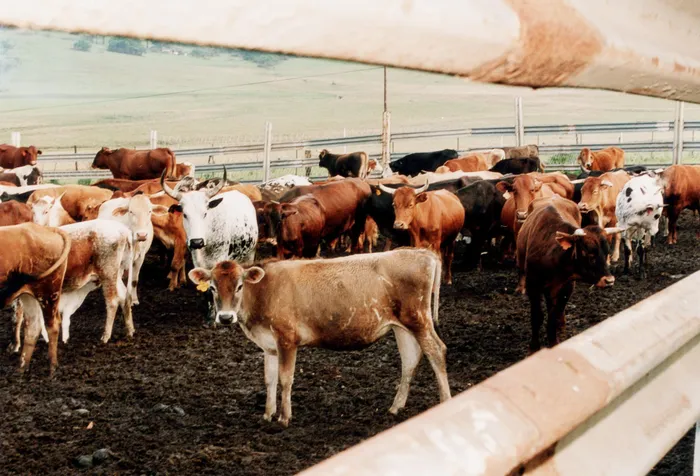Steenhuisen calls for a robust strategy to combat Foot and Mouth Disease outbreak
AGRICULTURE

This comes as the agricultural industry is reeling from the economic toll of the ongoing FMD outbreak, with losses that run into hundreds of millions of rand and threatened food security.
Image: Neo Ntsoma/Independent Newspapers
Minister of Agriculture, John Steenhuisen, has decried the country’s level of preparedness to deal with the outbreak of the Foot and Mouth Disease (FMD).
This comes as the agricultural industry is reeling from the economic toll of the ongoing FMD outbreak, with losses that run into hundreds of millions of rand and threatened food security.
Speaking at the FMD Indaba on Monday, Steenhuisen said the disease has brought sobering lessons to light, exposing weaknesses in the response system during the most recent outbreak.
“What we saw was a response system stretched to its limits, with breakdowns in communication, severe delays in vaccine availability, confusion over movement controls, and an alarming lack of readiness at several levels of government. Farmers were unsure of the measures. Provinces were uncertain of the protocols. And while the virus spread, trust in the State’s capacity to respond continued to erode,” Steenhuisen said.
“One of the most damaging consequences of this outbreak was our inability to contain the economic fallout. Because South Africa has no functional regionalisation framework, the entire country was penalised through the eyes of our trading partners, despite the outbreak being localised to specific zones. Exports of cloven-hoofed animals, and their products, were suspended or slowed. Jobs were lost. And the reputational damage to our animal health system is one that will take time, and action, to repair.
“The core lesson is this: we cannot continue managing FMD outbreaks with outdated structures and fragmented authority, hoping that a patchwork of short-term measures will deliver long-term stability. We need an innovative approach––one that is science-based, constitutionally aligned, and practically implementable.”
As a result, Steenhuisen said the industry must urgently and properly regionalise its disease control framework.
Steenhuisen said every credible trading nation acknowledges that a localized outbreak should not lead to sweeping restrictions across an entire country yet South Africa lags in establishing, certifying, and maintaining disease control zones that align with international standards.
“Let me be clear: the failure to regionalise is not due to a lack of veterinary science. It is due to a lack of institutional coordination, legal clarity and capacity,” he said.
“To address this, I have appointed two senior veterinarians, Dr Emily Mogajane and Dr Nomsa Mnisi with extensive field, government and international trade experience to lead the development of a comprehensive national regionalisation framework.”
Steenhuisen said another glaring issue during the outbreak was the lack of vaccine availability.
With the national FMD vaccine bank depleted, South Africa was forced to import vaccines from Botswana, underscoring a system that is not sustainable given our livestock footprint and export ambitions.
Steenhuisen said the government was stabilising Onderstepoort Biological Products, the leading distributor of livestock vaccines, but that will take time thus vaccine security requires private sector partnership.
“We are calling on the livestock industry, especially the red meat, dairy and game sectors, to begin co-financing vaccine procurement,” Steenhuisen said.
“This does not mean you will manage the vaccines or the cold chains. But it does mean that, like in other agro-industries, we establish structured partnerships that ensure we are not caught unprepared again.”
Furthermore, Steenhuisen said infrastructure deficits within the protection zones have hindered effective movement control. He said animals are often moved illegally due to the absence of local abattoirs or feedlots, complicating the enforcement of necessary regulations.
As a result, he said funding will be allocated this year to support the establishment of feedlots and abattoirs within the protection zones, predominantly in Limpopo, KwaZulu-Natal, and Mpumalanga, creating rural jobs and aiding the enforcement of FMD control measures.
To combat the spread of animal diseases and address the growing challenges of climate change, Steenhuisen said investment in scientific research and development was essential.
Steenhuisen said initiatives were underway to collaborate with the National Agricultural Marketing Council to earmark a portion of statutory levies for research targeting both animal health and climate resilience.
He also said the Agricultural Research Council (ARC) was poised for a resurgence, having recently achieved a surplus, signalling the potential for a renewed focus on core scientific capabilities.
Strategic partnerships with institutions such as the University of Pretoria's Biosecurity Hub are set to elevate South Africa's research ecosystem to meet both biosecurity and climate challenges, fostering a more resilient agricultural sector.
“To ensure that these outcomes of this Indaba are not just aspirational but actionable, I will be appointing a dedicated team immediately after this gathering to consolidate the proposals and insights shared here today,” he said.
“This team will be tasked with finalising a practical, time-bound operational plan, one that reflects both the urgency of our challenge and the collective wisdom in this room. That plan will be presented to me within a defined timeframe and will serve as the blueprint for our implementation going forward.”
BUSINESS REPORT